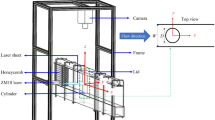Abstract
In order to find the intrinsic physical mechanism of the original Kármán vortex wavily distorted across the span due to the introduction of three-dimensional (3-D) geometric disturbances, a flow past a peak-perforated conic shroud is numerically simulated at a Reynolds number of 100. Based on previous work by Meiburg and Lasheras (1988), the streamwise and vertical interactions with spanwise vortices are introduced and analyzed. Then vortex-shedding patterns in the near wake for different flow regimes are reinspected and illustrated from the view of these two interactions. Generally, in regime I, spanwise vortices are a little distorted due to the weak interaction. Then in regime II, spanwise vortices, even though curved obviously, are still shed synchronously with moderate streamwise and vertical interactions. But in regime III, violently wavy spanwise vortices in some vortex-shedding patterns, typically an \(\Omega \)-type vortex, are mainly attributed to the strong vertical interactions, while other cases, such as multiple vortex-shedding patterns in sub-regime III-D, are resulted from complex streamwise and vertical interactions. A special phenomenon, spacial distribution of streamwise and vertical components of vorticity with specific signs in the near wake, is analyzed based on two models of streamwise and vertical vortices in explaining physical reasons of top and bottom shear layers wavily varied across the span. Then these two models and above two interactions are unified. Finally two sign laws are summarized: the first sign law for streamwise and vertical components of vorticity is positive in the upper shear layer, but negative in the lower shear layer, while the second sign law for three vorticity components is always negative in the wake.






























Similar content being viewed by others
References
Sarpkaya, T.: A critical review of the intrinsic nature of vortex-induced vibrations. J. Fluids Struct. 19, 389–447 (2004)
Williamson, C.H.K., Govardhan, R.: Vortex-induced vibrations. Annu. Rev. Fluid Mech. 36, 413–455 (2004)
Williamson, C.H.K., Govardhan, R.: A brief review of recent results in vortex-induced vibrations. J. Wind Eng. Ind. Aerodyn. 96, 713–735 (2008)
Sarpkaya, T., Isaacson, M.: Mechanics of Wave Forces on Offshore Structures. Van Nostrand Reinhold Company, Washington (1981)
Kumar, R.A., Sohn, C.H., Gowda, B.H.L.: Passive control of vortex-induced vibrations: an overview. Recent Patents Mech. Eng. 1, 1–11 (2008)
Owe, J.C., Bearman, P.W., Szewczyk, A.A.: Passive control of VIV with drag reduction. J. Fluid Struct. 15, 597–605 (2001)
Korkischko, I., Meneghini, J.R.: Suppression of vortex-induced vibration using moving surface boundary-layer control. J. Fluids Struct. 34, 259–270 (2012)
King, R., Brown, A., Braaten, H., et al.: Suppressing full-scale riser VIV with the VT suppressor. In: Proceedings of 32nd International Conference on Ocean, Offshore and Arctic Engineering (OMAE2013) (ASME), Nantes, France, June 9–14, OMAE2013-11642 (2013)
Xu, F., Chen, W.L., Xiao, Y.Q., et al.: Numerical study on the suppression of the vortex-induced vibration of an elastically mounted cylinder by a travelling wave wall. J. Fluids Struct. 44, 145–165 (2014)
Lee, L., Allen, D.W.: The dynamic stability of short fairings. In: Offshore Technical Conference, Houston, TX, USA, OTC-17125 (2005)
Huera-Huarte, F.J.: On splitter plate coverage for suppression of vortex-induced vibrations of flexible cylinders. Appl. Ocean Res. 48, 244–249 (2014)
Trim, A.D., Braaten, H., Lie, H., et al.: Experimental investigation of vortex-induced vibration of long marine risers. J. Fluid Struct. 21, 335–361 (2005)
Owen, J.C., Szewczyk, A.A., Bearman, P.W.: Suppression of Kármán vortex shedding. Gallery Fluid Motion Phys. Fluids 12, 1–13 (2000)
Darekar, R.M., Sherwin, S.J.: Flow past a square-section cylinder with a wavy stagnation face. J. Fluid Mech. 426, 263–295 (2001)
Lam, K., Lin, Y.F.: Effects of wavelength and amplitude of a wavy cylinder in cross-flow at low Reynolds numbers. J. Fluid Mech. 620, 195–220 (2009)
Lin, L.M., Zhong, X.F., Wu, Y.X.: Flow around a circular cylinder with radial disturbances at a low Reynolds number. In: Proceedings of Twenty-third International Offshore Polar Engineering Conference (ISOPE), Anchorage, Alaska, USA, June 30–July 5, 387–394 (2013)
Lin, L.M., Zhong, X.F., Wu, Y.X.: Effect of peak perforation on flow past a conic cylinder at \(Re=100\): drag, lift and Strouhal number. China Ocean Eng. 31, 330–340 (2017)
Roshko, A.: On the Development of Turbulent Wakes from Vortex Streets. NACA Report 1191 (1954)
Williamson, C.H.K.: Vortex dynamics in the cylinder wake. Annu. Rev. Fluid Mech. 28, 477–539 (1996)
Lin, L.M.: Wake dynamics and forces in the flow around the square-section cylinder with a geometric disturbance. Ph.D. Thesis, Institute of Mechanics, CAS, Beijing, China (2007) (in Chinese)
Lin, L.M., Zhong, X.F., Wu, Y.X.: Effect of perforation on flow past a conic cylinder at \(Re=100\): vortex shedding pattern and force history. Acta Mech. Sin. 34, 238–256 (2018)
Lin, L.M., Zhong, X.F., Wu, Y.X.: Characteristics for a flow past a circular cylinder with two types of radial disturbances at \(Re=100\). Adv. Mater. Res. 871, 107–114 (2014)
Meiburg, E., Lasheras, J.C.: Experimental and numerical investigation of the three-dimensional transition in plane wakes. J. Fluid Mech. 190, 1–37 (1988)
Henderson, R.D.: Nonlinear dynamics and pattern formation in turbulent wake transition. J. Fluid Mech. 352, 65–112 (1997)
Newman, D.J., Karniadakis, G.E.: A direct numerical simulation study of flow past a freely vibrating cable. J. Fluid Mech. 344, 95–136 (1997)
Acknowledgements
The project was financially supported by the National Key Scientific Instrument and Equipment Development Program of China (2011YQ120048).
Author information
Authors and Affiliations
Corresponding author
Rights and permissions
About this article
Cite this article
Lin, L.M., Zhong, X.F. & Wu, Y.X. Effect of perforation on flow past a conic cylinder at \({\varvec{Re}}~=~100\): wavy vortex and sign laws. Acta Mech. Sin. 34, 812–829 (2018). https://doi.org/10.1007/s10409-018-0758-z
Received:
Revised:
Accepted:
Published:
Issue Date:
DOI: https://doi.org/10.1007/s10409-018-0758-z




